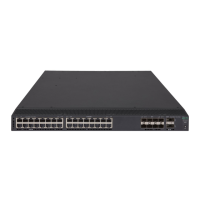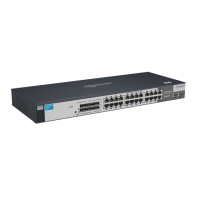26
Configuring VSANs
The virtual storage area network (VSAN) technology breaks a physical SAN into multiple VSANs, and
provides more secure, reliable, and flexible services.
Devices in a VSAN cannot get information about any other VSAN and devices in any other VSAN. Each
VSAN performs the following operations independently:
• Selecting a principal switch.
• Assigning domain IDs.
• Running routing protocols.
• Maintaining routing table and FIB table.
• Providing services.
The VSAN technology delivers the following benefits:
• Improved security—VSANs are isolated from each other.
• Improved scalability—Each VSAN independently runs and provides services. Different VSANs can
use the same address space so that network scalability is improved.
• Flexibility—You can assign interfaces to different VSANs without changing the physical
connections of the SAN.
VSAN fundamentals
The VFC interfaces in a VSAN can work as trunk ports. A trunk port can belong to multiple VSANs.
VFC interfaces can only work as trunk ports.
Trunk VSAN in an FC network
The trunk VSAN technology implements logical isolation among VSANs. The trunk VSAN adds a Virtual
Fabric Tagging Header (VFT_Header, also known as VSAN tag) to the FC frames. The VFT_Header
contains a VF_ID (also known as "VSAN ID") field to indicate the VSAN of the FC frames. In this way, FC
frames with different VF_IDs are contained in their respective VSANs, and different VSANs cannot
communicate with each other. The trunk VSAN implements physical connectivity and logical isolation in
the network.
During the transmission process, VFT_Headers are added to and removed from the frames. A switch can
use the same physical interface to support multiple VSANs. The trunk VSAN technology reduces the
number of physical connections, actually implementing logical isolation in a physical network.
Trunk VSAN in an FCoE network
FCoE carries FC over Ethernet. In an FCoE network, VSANs in FC must be mapped to VLANs as
configured by the user, and the FIB table for a VSAN is also stored on the relevant VLAN. FCoE frames
use VLAN_Header in place of VFT_Header in FC frames and are forwarded based on the VLAN ID in
VLAN_Header.
A VFC interface can only work as a trunk port. The bound Ethernet interface must also be configured as
a trunk port, and its trunk VLAN list must include the VLANs mapped to each VSAN in the trunk VSAN
